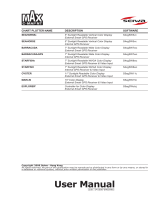Page is loading ...

UX0GPGxx 10-35V (10 mt. cable)
Issue A220302

1. INTRODUCTION
This GPS receiver module is based on a ultimate 12 channel GPS engine. The GPS
engine, interface electronics, and a passive GPS antenna are enclosed inside the weather-
proof plastic housing. This provides sophisticated state of the art GPS performance in an
easy to use package.
1.1) FEATURES AND SPECIFICATIONS
Receiver Architecture
.12 parallel channels "All in view" tracking
.L1 frequency 1575.42 MHz, C/A code
Tracking Capability
.Platform velocity up to 515 m/s (1854 Km/h)
.Platform acceleration up to 4 g
Accuracy
.25 meter, 2D without SA imposed (95%)
.100 meter, 2D RMS with SA imposed (95%)
.Timing Accuracy 1pulses/sec, aligned with GPS time +/- 1µs
Acquisition/Reacquisition Performance (typical)
.8 sec. Time To First Fix (with almanac, ephemeris, time and position)
.40 sec. TTFF (with almanac, time and position)
.60 sec. TTFF (cold start)
.0.1 sec. reacquisition (up to 30 sec. blockage)
Map Datum
.default WGS-84
NMEA-0183 Data Port
.NMEA-0183 Version 2.01 (selected formats)
.Default Output message GGA, GSA, GSV, RMC
.Input/Output signals RS232 (TTL level)
.Default data format 4800 baud, no parity, 8 data bits, 1 stop bit (4800 N81)
Power Requirements
. 1 watt @ 10 Vdc
Operating Temperature
.-20 degrees C to 75 degrees C
Storage Temperature
.-55 degrees C to 90 degrees C

1.2) UX0GPG00xx GPS RECEIVER CABLE P. # CBC0FS0704
Conxall Connector Wire Colour Description Signal Specification
Pin n. Signal Name
1 GPS RX + green NMEA-0183 signal RS232C 4800 N81
received from plotter
2 GPS TX + brown NMEA-0183 signal "RS232C" (0 to 5V)
transmitted to plotter 4800 N81
4 GPS RX - gray signal ground
3 GPS TX - yellow signal ground
6 GND black signal ground
--- - shield shield
5 NC white
7 GPS PWR + red 10 to 35 volts DC
supply input
Figure 1.2 - Connector Pin Out
Figure 1.2a - Mechanical dimensions
NC

1.4) UNPACKING AND INSPECTION
Carefully remove the system parts from the packing container. Ensure that the following
system parts are enclosed:
• GPS Receiver/Antenna
• Interface Cable (10 metres)
Inspect the packaging and system parts for any signs of damage in transit. If any damage
is found notify the carrier and supplier immediately.
1.5) INSTALLATION
WARNING
Take care in fitting the GPS as incorrect fitting can cause irrepairable damage and would not be
covered by warranty. See Installation Instructions in the relevant Manual.
A 10 metre cable plugs in to the Antenna (an optional 15 m cable is available, Part
Number 510 541). The mounting position must be selected carefully. The satellite posi-
tions are continuously changing relative to the vessel and in addition, the vessel’s heading.
As reception is strictly “line of sight”, between each satellite and the receiving Antenna, it is
essential that the Antenna has a clear view of the hemisphere of sky from the horizon up-
wards. Minor shadows caused by rigging wires will not upset either reception or the result-
ant position fixing. Two effects may be caused by the proximity of metallic objects:
a) Shadowing, the “line of sight” being obscured and reception from one or more satel-
lites lost. Metal masts, radar scanners, radar reflectors or superstructures are typical
causes of such shadowing.
b) Distortion of the Antenna polar diagram which may decrease the effective level of
the received signal.
The antenna SHOULD BE MOUNTED:
• more than 1 metre from wire rigging
• more than 2 metres from metal objects greater than 200 mm in any direction and
above the Antenna base
• more than 3 metres from other satellite services Antennas such as Geostar, Locstar,
Inmarsat
• outside the possible beam width of an Inmarsat standard A Antenna or a Radar
• with nothing on top of the unit
As the Antenna is receiving its signals from satellites above the horizon it is not neces-
sary to mount the Antenna at the mast top on sailing yachts or at the highest point on com-
mercial or other powered vessels. In fact there are disadvantages in that the accuracy of
GPS will tend to show the Antenna’s athwartships velocity component, dependent on the
height of the Antenna above sea level and the rolling period of the vessel.
The smaller vessel may roll quickly and an Antenna mounted from the mast top may
result in the display of a cyclic variation in Speed Over the Ground as well as small unnec-
essary position changes.
On larger power driven vessels and commercial ships, the rolling velocity is likely to be

lower and an Antenna mounted high up will not suffer the athwartships velocities or accel-
erations of small vessels and the result will be satisfactory.
Summarising therefore, the Antenna must be mounted so as to have a clear view of the
sky from the horizon upwards, must be clear of wire rigging and other larger metal objects
as referred to above and, not subjected to excessive rolling velocities.
You will need to supply a suitable standard VHF antenna mount.
Fill the connector with silicone grease to prevent corrosion of the plug connector.
CABLE ROUTING
When installing the GPS it is important that the cable is not fitted in close proximity to
antennae cables or cables carrying high currents. If the cable has to follow a similar route to
cables of this type, ensure the distance between the cables is >100 mm.
SCREEN CONNECTION
Where a Screen/Chassis connection is available, (NOT SS -ve or Battery -ve), connect
the Screen of the GPS cable to this point.
/


